

Dambisa Moyo: Is China the new idol for emerging economies? Eric X. Li: A tale of two political systems. Developing Asia and the middle-income trap. Author: Homi Kharas, Brookings Institution Developing Asia’s share of global GDP has risen inexorably over the last 30 years: 7.5 per cent in 1980, 10.5 per cent in 1990, 14.5 per cent in 2000 and 26 per cent projected for this year.
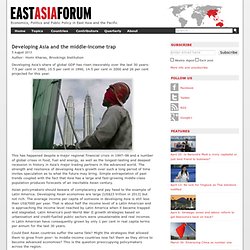
US should adapt to new growth order - Frontpage - OP-ED. Photo taken on October 4, 2013 shows banners of APEC summit in the street of Bali, Indonesia.
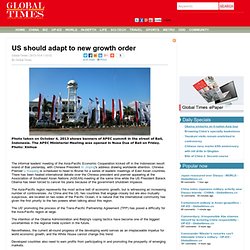
The APEC Ministerial Meeting was opened in Nusa Dua of Bali on Friday. Photo: Xinhua The informal leaders' meeting of the Asia-Pacific Economic Cooperation kicked off in the Indonesian resort island of Bali yesterday, with Chinese President Xi Jinping's address drawing worldwide attention. Chinese Premier Li Keqiang is scheduled to head to Brunei for a series of leaders' meetings of East Asian countries. Our_frugal_future.pdf. Framework of Inclusive Growth Indicators 2012: Key Indicators for Asia and the Pacific. Description The Framework of Inclusive Growth Indicators 2012 (FIGI 2012) is the follow-up edition to FIGI 2011, which proposed a set of 35 indicators as measures of income and non-income outcomes of inclusive growth; the processes and inputs that are important to improve access to opportunities, social inclusion, social safety nets; and good governance and institutions.
Part 1 provides a comparative analysis of the state of inclusive growth in developing Asia and in the other developing regions of the world – Latin America and the Caribbean and Sub-Saharan Africa – based on the FIGI indicators. It also examines the correlations between indicators of poverty and inequality outcomes, on the one hand, and indicators for processes, inputs, and good governance and institutions; on the other; and draws policy implications from the results. Is Growth in Asia and the Pacific Inclusive? Description Inclusive economic growth challenges governments to achieve a high, sustainable rate of economic growth and to share opportunity equitably across society.
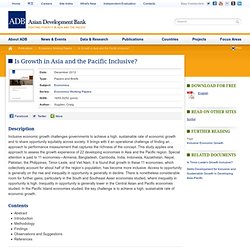
Framework of Inclusive Growth Indicators 2012: Key Indicators for Asia and the Pacific. Sovereign wealth funds gain assets… Asian hedge funds enjoy positive September… Sovereign wealth funds globally have added more than USD750bn to their total assets since last year, according to research firm Preqin.

The growth, from USD4.62 trillion assets under management in 2012 to USD5.38 trillion in 2013, is largely down a number of new funds formed over the last few years, according to the firm, as well as capital injected into existing sovereign wealth funds. Preqin says Asia-based sovereign wealth funds have shown some of the largest growth in assets under management, with the assets of these sovereign wealth funds growing, on average, by 19 per cent since 2012. This is in comparison to the average 6 per cent growth in assets under management exhibited by Middle Eastern sovereign wealth funds. In fact, Asia-based sovereign wealth funds account for a significant 47 per cent of global aggregate sovereign wealth fund assets, despite only representing 22 per cent of sovereign wealth funds globally by number.
The Future Global Reserve System - an Asian Perspective. Developing Asia's foreign exchange reserves have grown explosively since 1990.
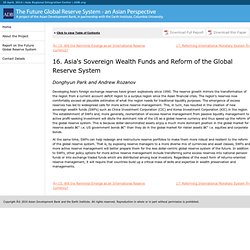
The reserve growth mirrors the transformation of the region from a current account deficit region to a surplus region since the Asian financial crisis. The region's reserves now comfortably exceed all plausible estimates of what the region needs for traditional liquidity purposes. The emergence of excess reserves has led to widespread calls for more active reserve management. Slide 1 - wcms_203906.pdf. India’s 12th 5-Year Plan: Where is the Indian Economy Headed, What Are India’s Priorities for the Next 5 Years, How is America Affected? Be an Informed Global Citizen and Business Person. Introduction: For a future business person interested in the economy and culture of India or doing business in India, the Indian government’s business plan’ aka 5-year planprovides a great foundation.
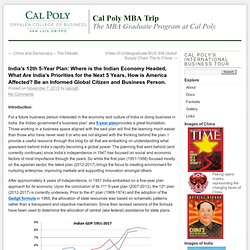
Those working in a business space aligned with the said plan will find the learning much easier than those who have never read it or who are not aligned with the thinking behind the plan. I provide a useful resource through this blog for all that are embarking on understanding what goes/went behind India’s rapidly becoming a global power. Economic planning in India: Tales of the unexpected. Banyan: The elusive fruits of inclusive growth. Framework of Inclusive Growth Indicators 2013: Key Indicators for Asia and the Pacific. Description The Framework of Inclusive Growth Indicators 2013 (FIGI 2013) is the third edition of the special supplement of the Key Indicators for Asia and the Pacific.

The framework is composed of 35 indicators used as measures of income and nonincome outcomes of inclusive growth; the processes and inputs that are important to improve access to opportunities, social inclusion, social safety nets; and good governance and institutions. The Elusive Quest for Inclusive Growth: Growth, Poverty, and Inequality in Asia. Inclusive Growth. From poverty reduction to inclusive growth Over the past decade, the Asia and Pacific region has successfully reduced income-based poverty and improved living standards for all, including the poor and those vulnerable to poverty.

Based on most recent international poverty figures, by 2005 about 27% of the Asia-Pacific populations live on less than $1.25 per person a day and 54% are vulnerable to poverty ($2). Frugal Innovation, an Indian approach of capitalism. Nano a 2200$ car,Frugal Innovation from Tata The emergence of Innovation in India “The frugal innovation” is synonymous with quality products and services, accessible to all.
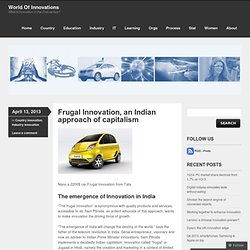
iShares MSCI Singapore Index Fund (ETF) (EWS): Why Chinese Officials Are In Love With The Singapore Model. In 1992, Deng Xiaoping, the former leader of the Chinese Communist Party who was instrumental in leading China to a market economy, described Singapore (EWS) as a strict, well-managed country that China must learn from and excel.
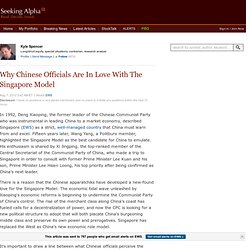
Fifteen years later, Wang Yang, a Politburo member, highlighted the Singapore Model as the best candidate for China to emulate. His enthusiasm is shared by Xi Jingping, the top-ranked member of the Central Secretariat of the Communist Party of China, who made a trip to Singapore in order to consult with former Prime Minister Lee Kuan and his son, Prime Minister Lee Hsien Loong, his top priority after being confirmed as China's next leader. There is a reason that the Chinese apparatchiks have developed a new-found love for the Singapore Model: The economic tidal wave unleashed by Xiaoping's economic reforms is beginning to undermine the Communist Party of China's control.
What's not to like? Receive future articles by this author via email: Cabinet announces plan to launch 'Well-being Index' Citing President Ma Ying-jeou who asked to launch a well-being measurement for Taiwan this year, Premier Jiang Yi-huah (江宜樺) said more countries are focusing attention on such measurements rather than just economic growth or unemployment. Shih Su-mei (石素梅), minister of the Executive Yuan's Directorate General of Budget, Accounting and Statistics (DGBAS, 主計處), added that as countries begin recognizing the limits of GDP as a measure of people's satisfaction with their lives, developing a well-being measurement becomes the next important step.
Shih said the “National Well-being Index” is inspired by the Organization for Economic Co-operation and Development's (OECD) “Better Life Index,” which measures up to 34 OECD member countries, including developed economies and emerging economies. As an example, Shih cited Bhutan that has the “Gross National Happiness” indicator, France has “Measuring Quality of Life,” and Britain has “National Well-being.” Bhutan's New Prime Minister Says Happiness Isn't Everything : Parallels. Hide captionTshering Tobgay receives appointment as prime minister in the Bhutanese capital, Thimpu, last week. AFP/AFP/Getty Images Tshering Tobgay receives appointment as prime minister in the Bhutanese capital, Thimpu, last week.
Sad but true, Bhutan's Gross National Happiness index is not immune to politics. Inclusive Growth Criteria and Indicators: An Inclusive Growth Index for Diagnosis of Country Progress. Description The paper constructs a composite inclusive growth index at the country level to measure contribution to inclusive growth. Indicators refer to (i) growth, productive employment, and economic infrastructure; (ii) income poverty and equity (including gender); (iii) human capability dimensions of inclusiveness; and (iv) social protection dimensions of inclusiveness. The methodology is then being applied in case study analysis for Bangladesh, Cambodia, India, Indonesia, the Philippines, and Uzbekistan. In Strange Company: The Puzzle of Private Investment in State-Controlled Firms. The following post comes to us from Professor Mariana Pargendler of the Fundação Getulio Vargas School of Law at São Paulo, Brazil.
Despite prior waves of privatization, state-owned enterprises (SOEs) remain a fixture of the variety of capitalism embraced by Brazil, Russia, India, and China as well as other emerging and developed economies. The state, however, is too often not alone in the companies it controls. Minority shareholdings in government-controlled firms are pervasive around the globe, and have been on the rise in a number of jurisdictions.
As of 2010, publicly traded SOEs accounted for a startling one-fifth of the world market capitalization. The coexistence of government and private stockholdings in business corporations is puzzling, and has long baffled observers. The full paper, which was recently made publicly available on SSRN, can be found here. Inclusive Growth Criteria and Indicators: An Inclusive Growth Index for Diagnosis of Country Progress - ADB-WP14-inclusive-growth-criteria.pdf. China's 12th Five Year Plan: Overview - China-12th-Five-Year-Plan-Overview-201104.pdf. Building a national happiness index in China.
Labour markets, human capital and inequality. Online Bookshop | iLibrary for subscribers | Further reading. Consumptionomics. Consumptionomics: Asia’s Role in Reshaping Capitalism and Saving the Planet, by Chandran Nair, Infinite Ideas, RRP£19.99, 256 pages Sales of Rolls-Royce cars rose 171 per cent last year, helped by heavy demand in China, India and other Asian countries, according to BMW, owner of the ultimate luxury car brand. Arguments for constrained capitalism in Asia. Workers guide cars at a parking space in Wuhan, in China. ADB Cuts Developing Asia Growth Forecasts. Inclusive growth revisited: Measurement and evolution.
Inclusive growth refers to both the pace and distribution of economic growth. For growth to be sustainable and effective in reducing poverty, it needs to be inclusive (Berg and Ostry 2011a, Kraay 2004); The Rise of Innovative State Capitalism. Over the past five years, as much of the developed world has staggered through crisis, a new type of capitalism has emerged as a challenger to laissez-faire economics. Emerging-market multinationals: The rise of state capitalism. Leapfrogging: New Approach to Economic Development · Sigma Scan. Distributed and wireless technologies may precipitate innovative strategies for economic growth in poor countries enabling the rapid development of economic infrastructure. Conventional approaches to economic development in poor countries have focused on slow but steady transformation through the development of open markets and civil society. Growing nations have been expected to follow a path to industrialisation similar to that of Western nations -- first exploiting natural resources through trade and then moving up the value chain into production and services.
A key component of this route to transformation is heavy public investment in large infrastructure networks for transportation, water, and power. However, developing countries in the 21st century rarely have the resources for such large infrastructure investments, and they face unprecedented population pressures quite unlike the Western experience of a century or more ago. The Idea of Inclusive Growth and Development Policy - psspwp3.pdf.
Implementing the MP3EI Paper.pdf. Yasheng Huang: Does democracy stifle economic growth? A critique of Eric X. Li’s “A tale of two political systems” By Yasheng Huang Earlier this year, economist Yasheng Huang (watch his 2011 TED Talk) sparred with Eric X. Eric X. Li: A tale of two political systems. Vietnam - A level playing field: Reforming the stated-owned sector. SOEs use several times more capital to produce one unit of output than the industry average. In 2000, the average ratio of turnover to capital (a proxy for the productivity of capital) in SOEs was 1.6 compared to 8.8 for the enterprise sector as a whole. This implies that an average SOE required nearly nine units of capital to produce one unit of output (turnover) compared to the industry average.
By 2009 the average ratio of turnover to capital for the SOEs fell to 1.1 while it increased to 21.0 for the industry (see figure 2.10).SOEs are also less efficient in their use of fixed assets such as land and machinery. Along with being operationally less efficient, SOEs are also found to be financially less prudent. Frugal Innovation, an Indian approach of capitalism. Microsoft Word - Well Being in India_Article_for printing.doc - Well Being in India_Article.pdf. State-controlled firms: The power and the glory. Building a national happiness index in China. India can recover faster than China on domestic consumption: RBI deputy governor.
India can recover from global economic slowdown faster than China as the economy is driven by domestic consumption, but the country needs to "get its act together" for this to happen, Reserve Bank Deputy Governor Anand Sinha said today. Sinha is in Beijing to take part in the Regional Policy Forum on Financial Stability and Macro-prudential Supervision. Speaking to PTI, Sinha also said "confidence issues like the general pessimism and not-so-good-feel factor also affected the economy". "Both economies (India and China) are affected by the global economic slowdown. But India being a domestic consumption driven economy, could recover faster," he said. "But for that we have to get our act together. When asked what should be done by India to arrest the slide in growth, he said, "We have to get hold of inflation. Chandran Nair, Global Institute for Tomorrow. Arguments for constrained capitalism in Asia. The Rise of Innovative State Capitalism.
Consumption in India likely to touch $3,600 billion in 2020. Emerging-market multinationals: The rise of state capitalism. East Asia Forum » Singapore in 2012: balancing growth with domestic imperatives » Print. Singapore Looks to a National Productivity Strategy to Maintain Growth. Blue Economy Indonesia. South Korea Sees Creativity as Key to Growth - Korea Real Time. Singapore in 2012: balancing growth with domestic imperatives. Singapore Looks to a National Productivity Strategy to Maintain Growth. Vietnam - A level playing field: Reforming the stated-owned sector. Vietnam - Vietnam Development Report (VDR) 2012: Market Economy for A Middle-income Country. PRMED - WhatIsInclusiveGrowth20081230. Strategies details. VietNam-GreenGrowth-Strategy.pdf. Implementing the MP3EI Paper.pdf. National Medium-Term Development Plan (RPJMN) Government of Indonesia 2010-2014. RPJMN_Presentation_8Feb2010.pdf. National Long‐Term Development Plan (RPJPN 2005‐2025) National Medium‐Term Development Plan (RPJMN 2010‐2014)
Are state-led economies better? Government Development Plans - Economic Development of Indonesia. RMK10_Eds.pdf. Twelfth Five Year (2012-17), Planning Commission, Yojana Bhawan, Government of India. China's 12th Five Year Plan: Overview - China-12th-Five-Year-Plan-Overview-201104.pdf. Chinas_12th_Five-Year_Plan.pdf.